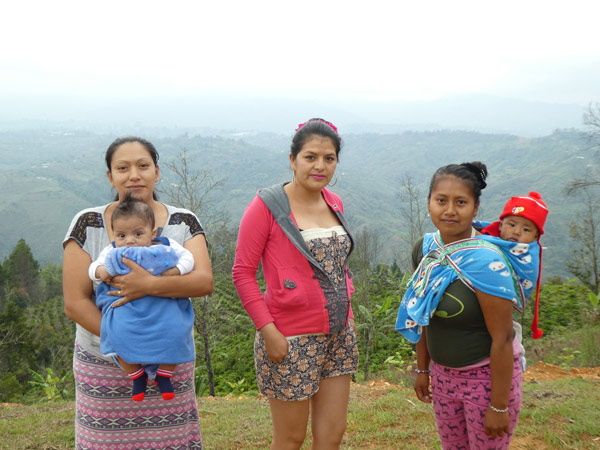After years of war, former combatants in Colombia are returning to the communities they left when they went to fight. The weapons have been laid down and the wounds are slowly beginning to heal. But the reintegration of former combatants remains precarious. PAX supports the indigenous authorities in their call for community reintegration. “It is not just the individual that needs to be taken into account, but also the social context, the family and the community,” says Joris van de Sandt, programme leader at PAX.
The Colombian government has set up a reintegration program for the ex-combatants in transition camps. “But that program is general, and focuses on the individual and not on the community,” says Van de Sandt. “It does not take the indigenous community into account.” The FARC forcefully recruited indigenous people, for example from the Cauca region, many of whom are still young, have little formal education and know little about the outside world. They were taken out of their familiar environment, then lived through the uncertainty of war, only now to find themselves stranded in a complex post-conflict situation.
Victim
Some of them feel victimized. They have lost contact with their family and indigenous community, a major issue within those communities. Conversely, victims of the war – those who did not play an active part in the conflict – view the ex-combatants as willing participants in the war. They believe that the government is rewarding perpetrators of atrocities with education, training and an allowance to return to society, while the real war victims are being left in the cold. These complex problems complicate reunification and reconciliation.
Cauca
Van de Sandt works frequently in Cauca, where, despite the peace, the highest number of political murders in Colombia take place. Civic leaders, most of them indigenous, are the most frequent victims. Cauca is home to 230,000 Nasa Indians who live in indigenous reserves, with their own administration and jurisdiction. The reserves were caught in the crossfire between guerrilla groups (the FARC and ELN) in the mountains, and the army and paramilitaries in the valleys.

Former combatants in the Pueblo Nuevo camp.
PAX called in for help
In anticipation of external funding, PAX is investing its own money in a pilot project to reintegrate 100 former combatants into three different indigenous communities. The aim is to scale up the pilot to include 600 to 800 former combatants. The request for assistance in the reintegration process comes from the Indian leaders themselves.
Armed groups
A large group of ex-combatants have not gone to the transition camps, but decided to demobilized on their own. They simply went home, which means the government does not recognize them as former combatants. As a result, they are not entitled to support. They are not guaranteed indemnification, which means that they can’t start again with a clean slate. On the other hand, many former fighters follow the official demobilization route in the transition camps and then return to their communities. During this transition time, they spend some of their time in the transition camps and some with their families. In either case, many ex-combatants end up in coca cultivation due to lack of work or assistance, or they re-join an armed group.

Women in the Caldono camp.
Restoring harmony
“Careful reintegration must be paramount,” says Van de Sandt, “in order to restore harmony in the community. That reduces the chance of new conflicts due to unresolved problems.” PAX helps guide the reintegration in three communities that differ greatly in how they deal with ex-combatants: Caldono, Buenos Aires and Jambaló. In Caldono, the indigenous authority treats former combatants relatively mildly. The ex-combatants must undergo conciliation rituals, receive cultural re-education and accept help to deal with trauma. The same conditions apply In Jambaló, but there the leaders and the community are stricter. The community fears that former fighters will bring with them bad habits they acquired during their lives with the FARC. Those who have committed crimes in their own community are subjected to indigenous justice. Van de Sandt: “The risk of such a strict attitude is that former combatants will react by going back to their old lives, joining dissident FARC groups. Or that indigenous authorities from different reserves get into conflict with each other because former fighters prefer to go to a community that deals with ex-combatants less strictly.” For instance, the municipality of Buenos Aires that is the most pragmatic of the three districts where PAX works.
Multiple challenges
According to the Peace Agreement, indigenous people are allowed to organize the reintegration, including the imposition of punishment. Yet this is a tricky issue. They believe that their indigenous jurisprudence must always have priority in their territories, even if the government judges want to be more lenient toward war criminals. Van de Sandt: “The challenge is to bring together national and indigenous transitional justice. Another challenge is to create a reintegration program for indigenous communities in accordance with their culture. That means a community-oriented approach. If the government does not allow this, new problems will arise.”
Recognition
Process guidance and reintegration in the community must be recognized by both the government and the FARC. “The task of PAX is to look for the official recognition of such an adapted reintegration program together with the indigenous leaders,” says Van de Sandt. So many challenges. As Gabriel Garcia Marques wrote in One Hundred Years in Solitude, “It is easier to start a war than to end it.”
Text and photos: Karin Anema




